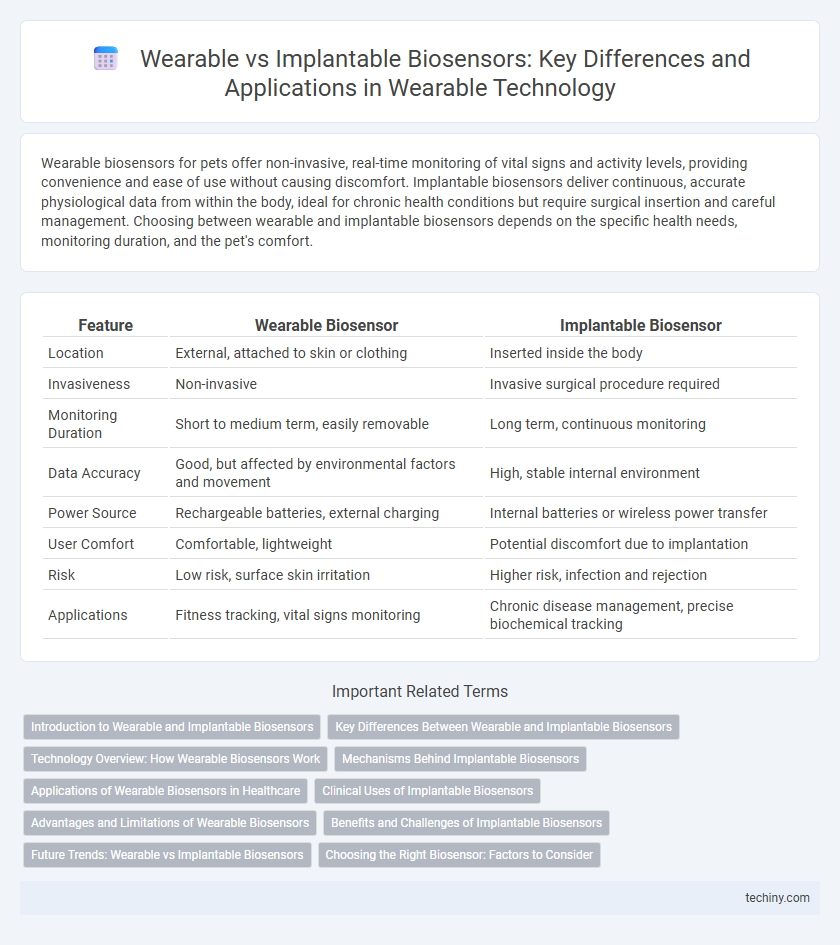Wearable biosensors for pets offer non-invasive, real-time monitoring of vital signs and activity levels, providing convenience and ease of use without causing discomfort. Implantable biosensors deliver continuous, accurate physiological data from within the body, ideal for chronic health conditions but require surgical insertion and careful management. Choosing between wearable and implantable biosensors depends on the specific health needs, monitoring duration, and the pet's comfort.
Table of Comparison
| Feature | Wearable Biosensor | Implantable Biosensor |
|---|---|---|
| Location | External, attached to skin or clothing | Inserted inside the body |
| Invasiveness | Non-invasive | Invasive surgical procedure required |
| Monitoring Duration | Short to medium term, easily removable | Long term, continuous monitoring |
| Data Accuracy | Good, but affected by environmental factors and movement | High, stable internal environment |
| Power Source | Rechargeable batteries, external charging | Internal batteries or wireless power transfer |
| User Comfort | Comfortable, lightweight | Potential discomfort due to implantation |
| Risk | Low risk, surface skin irritation | Higher risk, infection and rejection |
| Applications | Fitness tracking, vital signs monitoring | Chronic disease management, precise biochemical tracking |
Introduction to Wearable and Implantable Biosensors
Wearable biosensors continuously monitor physiological parameters through non-invasive or minimally invasive devices worn on the body, providing real-time health data such as heart rate, glucose levels, and physical activity. Implantable biosensors, meanwhile, are surgically embedded within the body to deliver highly accurate and long-term monitoring of internal biomarkers like blood chemistry and neural activity. Both technologies advance personalized healthcare by enabling continuous data collection and early detection of medical conditions.
Key Differences Between Wearable and Implantable Biosensors
Wearable biosensors offer non-invasive monitoring through devices like smartwatches and fitness bands, providing real-time health data without surgical procedures. Implantable biosensors, embedded inside the body, deliver continuous, precise measurements of physiological parameters such as glucose levels or cardiac activity, enabling long-term monitoring with higher accuracy. Key differences include invasiveness, data reliability, maintenance, and potential risks, where wearable sensors prioritize convenience and implantable sensors emphasize accuracy and longevity.
Technology Overview: How Wearable Biosensors Work
Wearable biosensors utilize non-invasive sensors embedded in smartwatches, fitness trackers, or patches to continuously monitor physiological data such as heart rate, glucose levels, or oxygen saturation through skin contact and optical or electrical signals. Advanced algorithms process real-time biometric data to detect anomalies and provide instant feedback or alerts for health management. Compared to implantable biosensors, wearable devices offer easier access and removal but may face challenges in sensor accuracy and data consistency due to external factors like movement and environmental interference.
Mechanisms Behind Implantable Biosensors
Implantable biosensors operate through direct interface with biological tissues, utilizing electrochemical, optical, or enzymatic mechanisms to continuously monitor vital biomarkers at the cellular level. These sensors often employ nanomaterials or biocompatible polymers to enhance sensitivity and reduce immune response, enabling real-time data transmission for critical health analytics. Unlike wearable biosensors, implantable devices provide long-term stability and precise monitoring by bypassing external interference and physiological barriers such as skin or sweat variability.
Applications of Wearable Biosensors in Healthcare
Wearable biosensors are widely utilized in healthcare for continuous monitoring of vital signs such as heart rate, glucose levels, and oxygen saturation, enabling real-time data collection and early detection of medical conditions. These devices support chronic disease management, fitness tracking, and rehabilitation by providing non-invasive, user-friendly solutions that enhance patient compliance and enable remote healthcare delivery. Compared to implantable biosensors, wearable biosensors offer greater accessibility and flexibility for monitoring health parameters without the need for surgical procedures.
Clinical Uses of Implantable Biosensors
Implantable biosensors provide continuous, real-time monitoring of critical biomarkers directly within the body, enhancing the management of chronic diseases such as diabetes through precise glucose level tracking. These sensors enable early detection of physiological changes by transmitting data to healthcare providers, improving patient outcomes with timely interventions. Compared to wearable biosensors, implantable devices offer higher accuracy and reliability in clinical settings by minimizing external interference and ensuring consistent performance over extended periods.
Advantages and Limitations of Wearable Biosensors
Wearable biosensors offer non-invasive, continuous health monitoring with easy accessibility and user comfort, making them ideal for real-time data collection in daily activities. Limitations include susceptibility to motion artifacts, limited battery life, and potential inaccuracies under varying environmental conditions. Despite these constraints, wearable biosensors provide a flexible, scalable solution for personalized health tracking compared to implantable biosensors, which require surgical procedures.
Benefits and Challenges of Implantable Biosensors
Implantable biosensors offer continuous, real-time monitoring of physiological parameters with high accuracy and minimal user intervention, benefiting chronic disease management and personalized healthcare. The challenges include potential biocompatibility issues, risk of infection, sensor degradation over time, and the need for surgical procedures for implantation and removal. Advances in materials science and wireless communication aim to address these limitations, improving longevity and patient comfort.
Future Trends: Wearable vs Implantable Biosensors
Future trends in wearable biosensors emphasize enhanced non-invasive monitoring capabilities, improved battery life, and integration with AI-driven health analytics for real-time data accuracy. Implantable biosensors are advancing towards prolonged biocompatibility, wireless power solutions, and precise internal biomarker detection, enabling continuous and reliable health monitoring. The convergence of both technologies aims to create hybrid biosensing systems that balance user comfort with comprehensive physiological insights for personalized medicine.
Choosing the Right Biosensor: Factors to Consider
Choosing the right biosensor involves evaluating criteria such as accuracy, biocompatibility, and ease of use in real-life settings. Wearable biosensors offer non-invasive monitoring and ease of removal, making them ideal for continuous health tracking and lifestyle convenience. Implantable biosensors provide higher precision and long-term stability but require surgical procedures and pose risks related to biocompatibility and device lifespan.
Wearable Biosensor vs Implantable Biosensor Infographic

 techiny.com
techiny.com